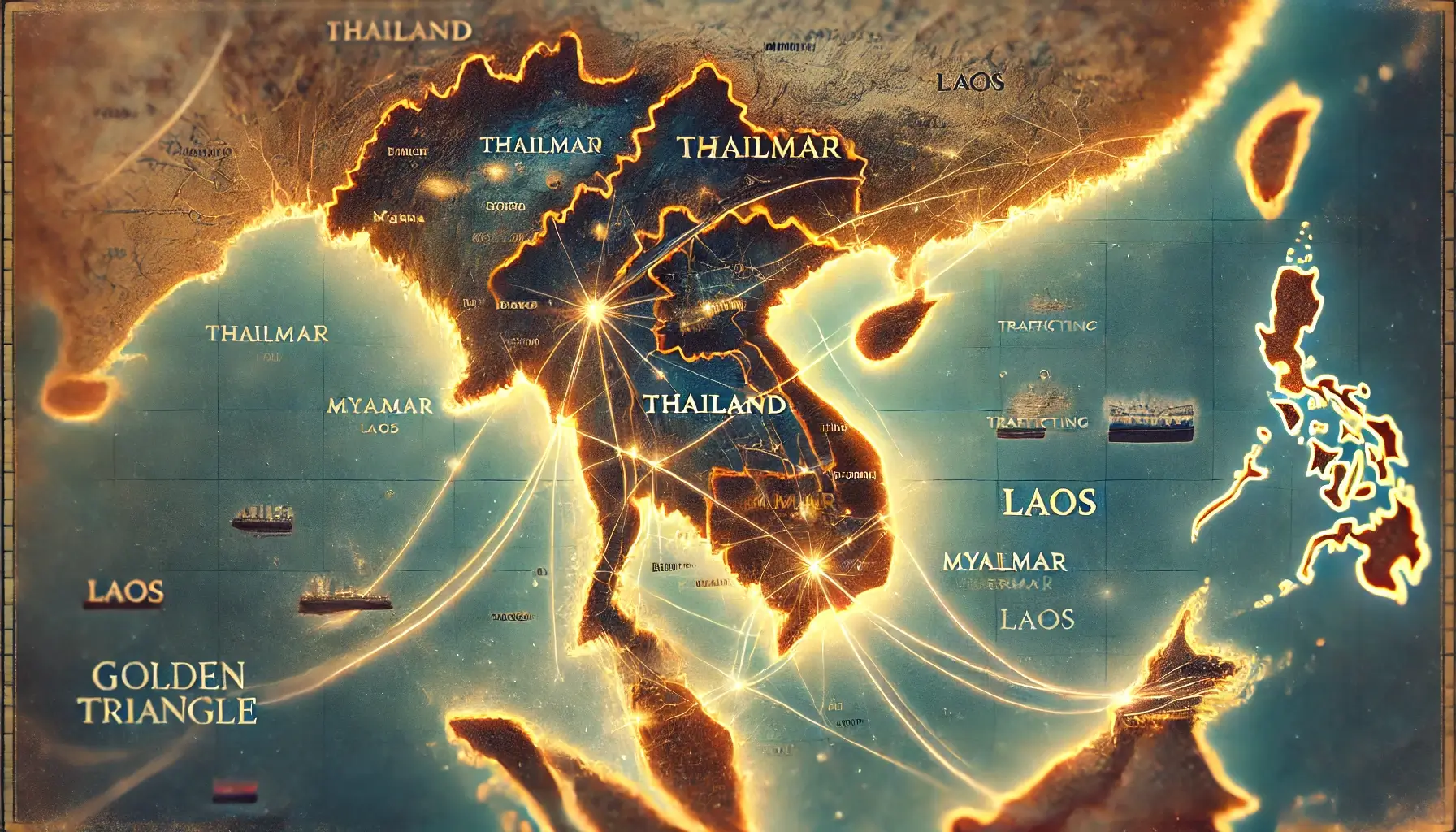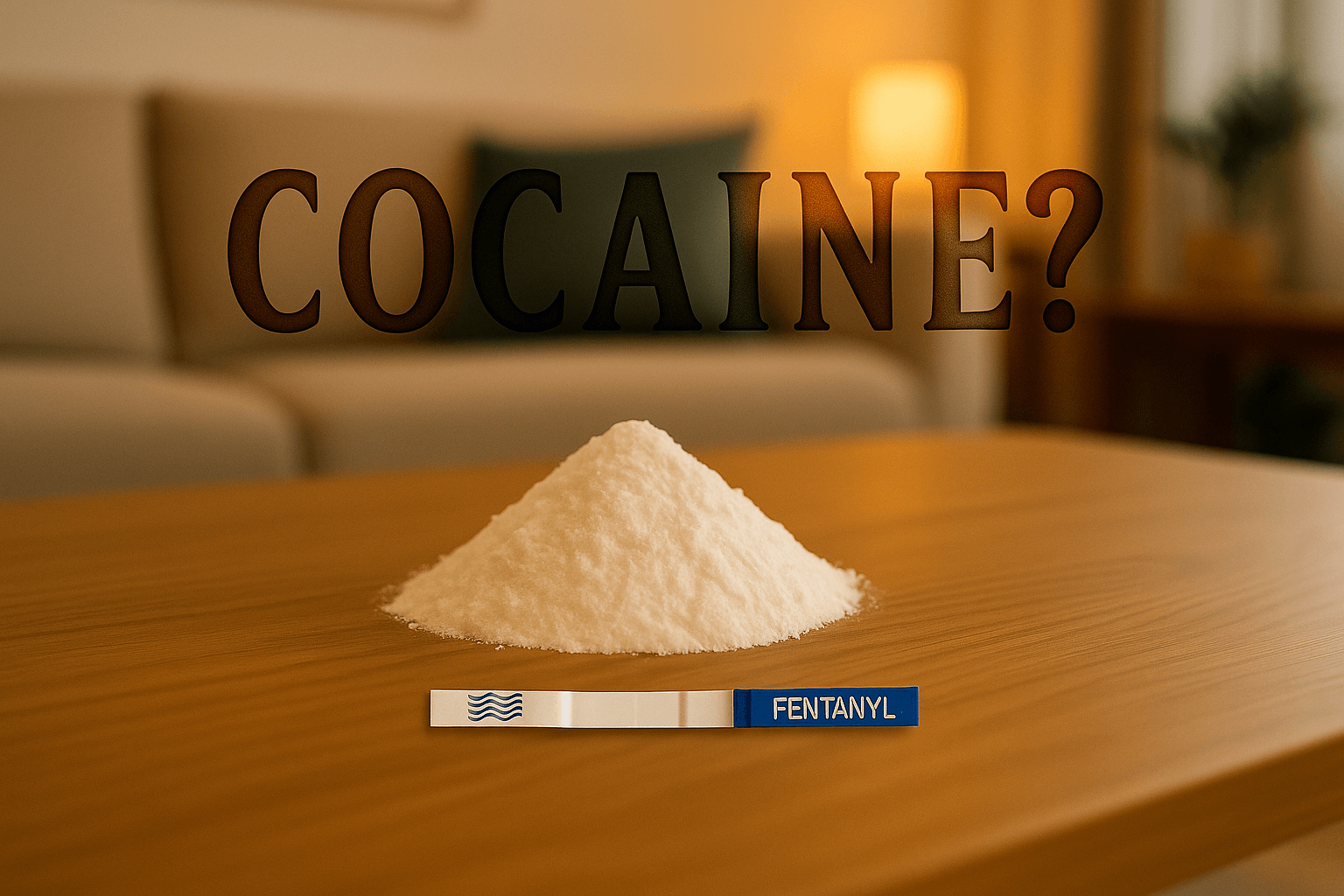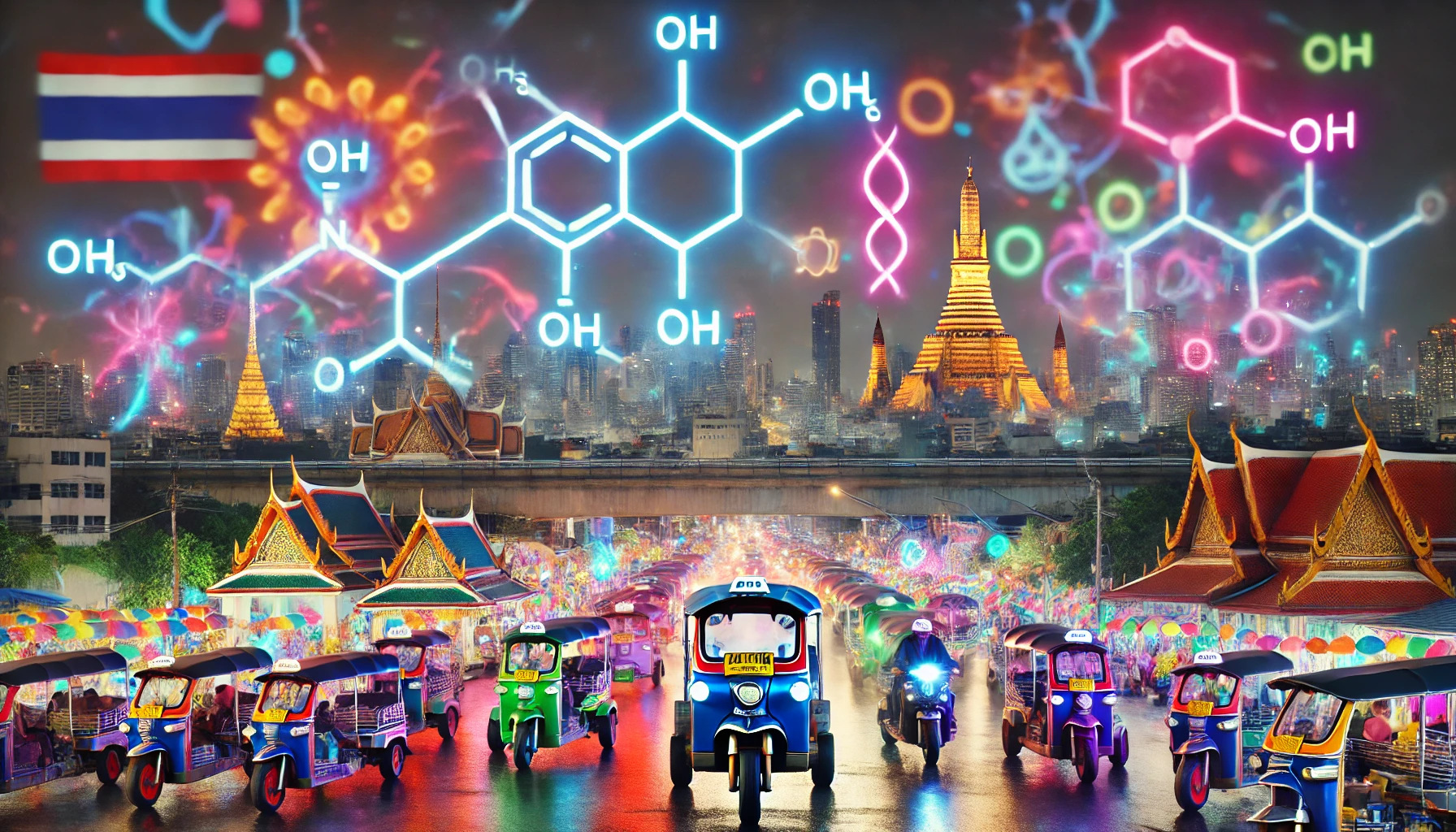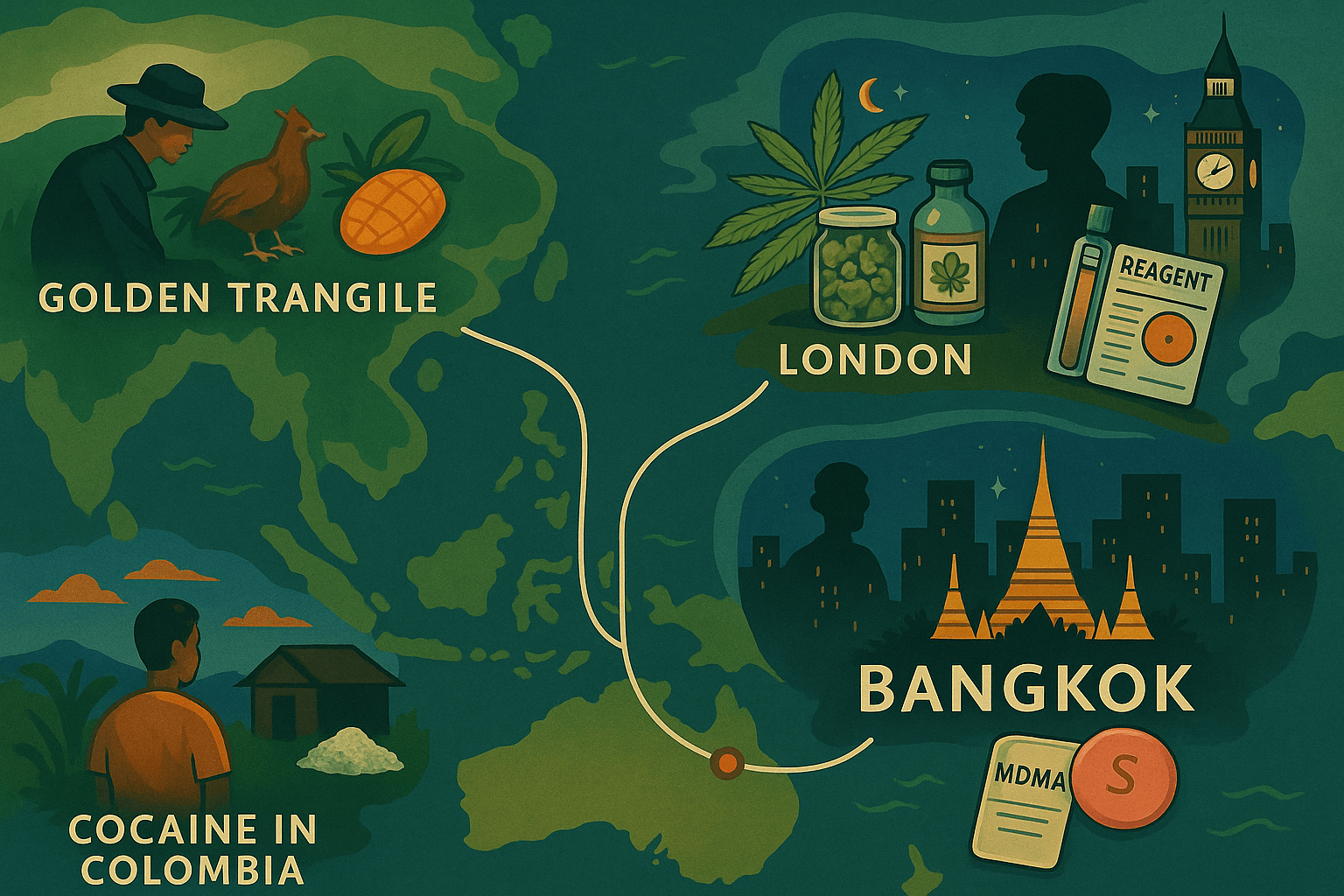Southeast Asia has long been a critical front in the global War on Drugs. Peter Jenkins’ The War on Drugs in Southeast Asia (HarperCollins, 1999) provides a detailed exploration of the region’s historical struggles with narcotics, revealing patterns that persist even today. From opium production in the Golden Triangle to methamphetamine’s (yaba) explosive growth in the 1990s, the book sheds light on how policies, economics, and cultural factors intersect in the ongoing battle against drugs.
This blog post revisits key insights from Jenkins’ work, contextualizing them for present-day Bangkok and highlighting how they remain relevant to harm reduction efforts, like those supported by Happy Test Shop.
The Golden Triangle: The Birthplace of Regional Trafficking
Jenkins emphasizes the Golden Triangle—where Thailand, Myanmar, and Laos converge—as the epicenter of Southeast Asia’s drug trade. Historically, the region was one of the world’s largest producers of opium, supplying both local and international markets. By the mid-20th century, heroin production became its primary focus, fueled by political instability and weak enforcement.
Key Takeaway:
The Golden Triangle’s geographic isolation made it a haven for traffickers. Armed insurgent groups controlled production and distribution, using drug profits to fund their activities.
Present Context:
While opium has declined, the Golden Triangle now dominates global methamphetamine production. Yaba and crystal meth (“ice”) are smuggled through Thailand into neighboring countries and beyond.
Thailand’s Unique Role in the War on Drugs
Jenkins highlights Thailand as a critical player in Southeast Asia’s drug policies. In the 1990s, Thailand faced a rising yaba epidemic, with tablets infiltrating schools, workplaces, and even rural villages. The government’s response was a combination of enforcement and prevention, but the balance often tipped toward punitive measures.
Jenkins’ Insight:
The War on Drugs in Thailand often prioritized visible crackdowns over long-term solutions. Mass arrests and publicized raids created the perception of progress but failed to address root causes like poverty and demand.
Fun Fact from the Book:
In one infamous 1990s operation, police staged a photo op with confiscated yaba tablets stacked into a tower, which subsequently collapsed mid-press conference. The incident became a symbol of the chaotic and reactionary nature of early drug enforcement efforts.
Recurring Patterns: Traffickers Adapt Faster Than Policies
One of Jenkins’ most striking observations is the adaptability of drug traffickers. As law enforcement targets one substance or route, traffickers shift to new drugs or methods.
- Example from the Book:
When heroin enforcement intensified, traffickers began mixing methamphetamine with caffeine to create yaba, which was easier to produce and transport.
Present Context:
Today, traffickers exploit global shipping routes, darknet markets, and even legal precursor chemicals to stay ahead. Jenkins’ insights underscore the need for proactive, not reactive, strategies.
The Cost of Over-Enforcement
Jenkins critiques the social consequences of Thailand’s harsh anti-drug measures. The War on Drugs launched by Prime Minister Thaksin Shinawatra in 2003 led to over 2,500 extrajudicial killings in its first year alone. While these measures temporarily reduced visible drug use, they also pushed trafficking further underground and alienated marginalized communities.
Jenkins’ Warning:
Over-enforcement creates more problems than it solves. Without addressing underlying issues like poverty, education, and addiction treatment, drug policies risk perpetuating the cycle of abuse and trafficking.
Relevance to Bangkok Today:
Bangkok’s bustling nightlife attracts both traffickers and users, making harm reduction initiatives vital. Jenkins’ analysis highlights why punitive approaches fail and why tools like drug testing kits are essential for fostering safer environments.
Harm Reduction: A Missing Piece in the War on Drugs
Jenkins notes that Southeast Asia’s early drug policies largely ignored harm reduction. While international organizations began advocating for measures like syringe exchange programs in the 1980s, these efforts gained little traction in Thailand until much later.
What’s Changed:
Today, harm reduction is gaining ground, with NGOs and community groups offering education, testing kits, and support for users. Jenkins’ work helps explain why these initiatives are necessary: they fill the gaps left by traditional enforcement.
Bangkok 2024: A New Chapter in the War on Drugs
Bangkok, as a global city and regional hub, is at the forefront of Southeast Asia’s evolving drug landscape. Jenkins’ observations from the 1990s remain strikingly relevant:
- Trafficker innovation: Synthetic drug production and trafficking continue to outpace regulation.
- Social impact: Punitive measures disproportionately affect vulnerable populations.
- Harm reduction’s potential: Testing kits, like those available at Happy Test Shop, can empower individuals to make safer choices, reducing harm without exacerbating social inequalities.
What’s Next?
Drawing from Jenkins’ patterns, Bangkok’s future in the War on Drugs will hinge on balancing enforcement with education and harm reduction. Proactive policies that adapt to new challenges, such as the rise of fentanyl-laced drugs, will be critical.
Call to Action: Learn from the Past, Act for the Future
Peter Jenkins’ The War on Drugs in Southeast Asia provides a sobering look at the complexities of combating narcotics. As Bangkok continues to navigate its role in this global battle, individuals can play a part by prioritizing safety and education.
Stay Safe Today: Visit Happy Test Shop for reliable drug testing kits that can detect methamphetamine, cocaine, MDMA, and contaminants like fentanyl. By staying informed, you help build a safer future.




